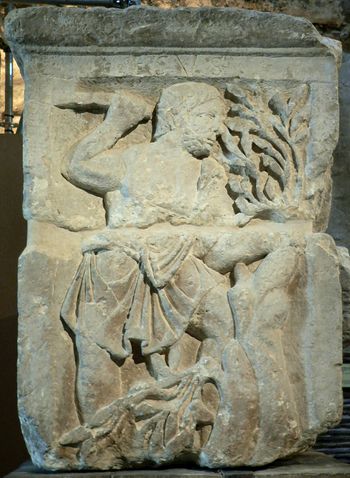エスス

エスス(Esus)[1]、ヘスス(Hesus)[2]、あるいはアイサス(Aisus[3])はブリトン人とガリア人の神で、二つの記念像とルカヌスの叙事詩『ファルサリア』の一節で知られている。
名前
T. F. O'Rahillyは、Aoibheall、Éibhleann、Aoifeなどの名前と同様に、Esusという名称をインド・ヨーロッパ語族の原語である*eis-に由来し、これを「幸福、エネルギー、情熱」と訳している[4]。
エスナートゥス(Esunertus、「エススの力」)という個人名は、マーキュリーに捧げられた奉納碑文を含むガロ・ローマ時代の多くの碑文に登場する[5][6]。またエスゲヌス(Esugenus、「エススから生まれた」)などの神話的な名前も確認されている[7]。現在のノルマンディー地方にあるガリアのエスヴィー族はエススから名前を取った可能性がある[8]。
図像
エススが登場する彫刻は、エススが名指しで描かれたパリの「船乗りの柱」[1]と、同様の図像を持つトレヴェリの「トリア」の柱の二つである[9][10]。いずれも、エススは斧で木の枝を切っている姿が描かれている[10]。エススは、「船乗りの柱」の別のパネルで、タルボス・トリガラヌス(「三羽の鶴を持つ雄牛」)、ユピテル、ヴァルカン、その他の神々と一緒に描かれている。
文献資料
有名なルカヌスの「ファルサリア」(61-65CE)の一節は、テウタテス、ヘスス(エススの吸引形)、タラニスというケルトの三神に捧げられた痛ましい生け贄について言及している引用エラー: 無効な <ref> タグです。
名前 (name 属性) が無効です (数が多すぎる、など)
The Gallic medical writer Marcellus of Bordeaux may offer another textual reference to Esus in his De medicamentis, a compendium of pharmacological preparations written in Latin in the early 5th century and the sole source for several Celtic words. The work contains a magico-medical charm decipherable as Gaulish which appears to invoke the aid of Esus (spelled Aisus) in curing throat trouble.[3]
Interpretations
John Arnott MacCulloch summarized the state of scholarly interpretations of Esus in 1911 as follows:
M. Reinach applies one formula to the subjects of these altars—"The Divine Woodman hews the Tree of the Bull with Three Cranes." The whole represents some myth unknown to us, but M. D'Arbois finds in it some allusion to events in the Cúchulainn saga. In the imagery, the bull and tree are perhaps both divine, and if the animal, like the images of the divine bull, is three-horned, then the three cranes (garanus, "crane") may be a rebus for three-horned (trikeras), or more probably three-headed (trikarenos). In this case, woodman, tree, and bull might all be representatives of a god of vegetation. In early ritual, human, animal, or arboreal representatives of the god were periodically destroyed to ensure fertility, but when the god became separated from these representatives, the destruction or slaying was regarded as a sacrifice to the god, and myths arose telling how he had once slain the animal. In this case, tree and bull, really identical, would be mythically regarded as destroyed by the god whom they had once represented. If Esus was a god of vegetation, once represented by a tree, this would explain why, as the scholiast on Lucan relates, human sacrifices to Esus were suspended from a tree. Esus was worshipped at Paris and at Trèves; a coin with the name Æsus was found in England; and personal names like Esugenos, "son of Esus," and Esunertus, "he who has the strength of Esus," occur in England, France, and Switzerland. Thus the cult of this god may have been comparatively widespread. But there is no evidence that he was a Celtic Jehovah or a member, with Teutates and Taranis, of a pan-Celtic triad, or that this triad, introduced by Gauls, was not accepted by the Druids. Had such a great triad existed, some instance of the occurrence of the three names on one inscription would certainly have been found. Lucan does not refer to the gods as a triad, nor as gods of all the Celts, or even of one tribe. He lays stress merely on the fact that they were worshipped with human sacrifice, and they were apparently more or less well-known local gods.[5]
___{{{author}}}
James McKillop cautions that Arbois de Jublainville's identification of Esus with Cú Chulainn "now seems ill-founded".[11]
Jan de Vries finds grounds of comparison between Esus and Odin, both being patrons of sailors sometimes associated with Mercury to whom human victims were said to be sacrificed by hanging.[8]
Miranda Green suggests that the willow-tree that Esus hews may symbolize "the Tree of Life [...] with its associations of destruction and death in winter and rebirth in the spring".[10] She further suggests that the cranes might represent "the flight of the soul (perhaps the soul of the tree)".[10]
In Neo-Druidism
The 18th century Druidic revivalist Iolo Morganwg identified Esus with Jesus on the strength of the similarity of their names. He also linked them both with Hu Gadarn, writing:
Both Hu and HUON were no doubt originally identical with the HEUS of Lactantius, and the HESUS of Lucan, described as gods of the Gauls. The similarity of the last name to IESU [Welsh: Jesus] is obvious and striking.[12]
___{{{author}}}
This identification is still made in certain Neo-Druidic circles. Modern scholars consider the resemblance between the names Esus and Jesus to be coincidental.
See also
- Lugus
- アレース
External links
- Esus, including photographs and a capitulation of primary and secondary source material.
- A contemporary Dutch-language story of struggle between Esus and Tarvos Trigaranus
参照
- ↑ 1.0 1.1 CIL, 13, 03026
- ↑ 引用エラー: 無効な
<ref>タグです。 「phars」という名前の引用句に対するテキストが指定されていません - ↑ 3.0 3.1 De medicamentis 15.106, p. 121 in Niedermann's edition; Gustav Must, “A Gaulish Incantation in Marcellus of Bordeaux,” Language 36 (1960) 193–197; Pierre-Yves Lambert, “Les formules de Marcellus de Bordeaux,” in La langue gauloise (Éditions Errance 2003), p.179, citing Léon Fleuriot, “Sur quelques textes gaulois,” Études celtiques 14 (1974) 57–66.
- ↑ T. F. O'Rahilly, 1946, Ir. Aobh, Aoibheall, etc. W. ufel, uwel. Gaul. Esus, Ériu, Royal Irish Academy, volume14 , pages1–6, jstor:30007645
- ↑ 5.0 5.1 J. A. MacCulloch (1911). ‘Chapter III. The Gods of Gaul and the Continental Celts.’ The Religion of the Ancient Celts. New York: Dover Publications., ISBN:0-486-42765-X.
- ↑ CIL, 13, 11644
- ↑ Jean Gricourt, 1958, L’Esus de Pétrone, Latomus, Société d’Études Latines de Bruxelles, volume17, pages102–109 , jstor:41518785
- ↑ 8.0 8.1 Jan de Vries (1954). Keltische Religion. W. Kohlhammer, Stuttgart. p.98. Cited here.
- ↑ Proinsias Mac Cana, Celtic Mythology, Hamlyn Publishing , London, 1970, pages32–35 Cited here (retrieved 2016-08-17).
- ↑ 10.0 10.1 10.2 10.3 Miranda Green, Symbol & Image in Celtic Religious Art, 1992, Routledge , London , pages103–104
- ↑ テンプレート:Cite book Cited here (retrieved 2016-08-17).
- ↑ Iolo Morganwg (1862, ed. J. Williams Ab Ithel). The Barddas of Iolo Morganwg, Vol. I.